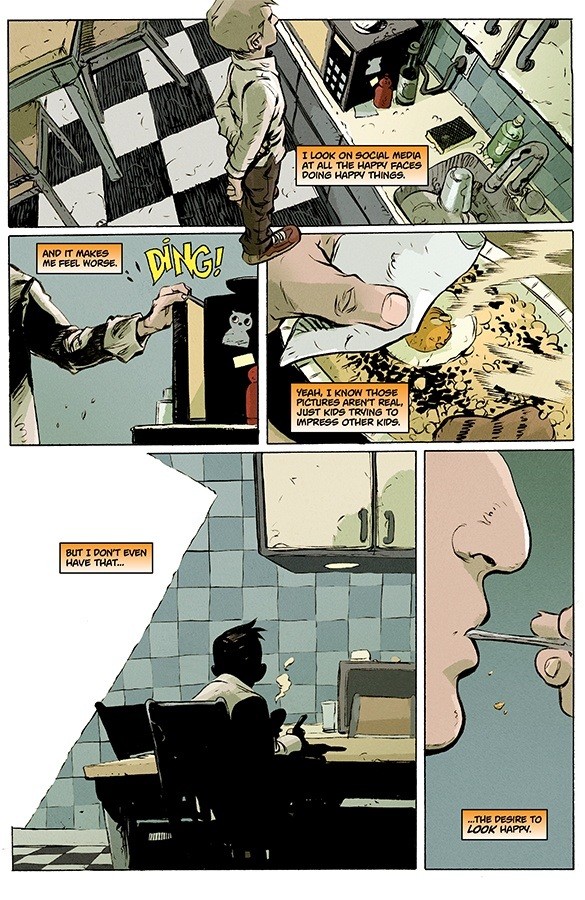Writer: Rodney Barnes
Artist: Alex Lins
Colorists: Luis Nct & Mar Silvestre Galotto
Letterer: Marshall Dillon
Cover Artists: Alex Lins & Luis Nct; Chris Visions
Publisher: Image
Price: 3.99
Release Date: May 10, 2023
Kurt’s mother walked out on him. His father found solace in alcohol. So where does that leave Kurt? And how are Travon and Daysha faring amid the alien invasion of Earth? Let’s leap into Monarch #4 and find out!

If you’re interested in this comic, series, related trades, or any of the others mentioned, then simply click on the title/link to snag a copy through Amazon as you read the Monarch #4 Review.
Story
Kurt’s never fit in anywhere. Other kids at school—and on social media—seem happy. Yet he doesn’t desire that. Anger sustains and drives him. With aliens destroying society, he can’t afford to weaken. He can’t trust friendship. He can’t give in to sadness. He needs to protect himself, which means protecting his anger. Although he was integral to their plans, the aliens now realize Travon has turned against them. He races toward the school, focused on saving Daysha. In the previous two issues, writer Rodney Barnes defined Travon more by his relationship with Miss Wilamae and Marli, his foster mother, and sister. Now he neither mentions nor mourns them. I wish I’d seen more of Travon’s relationship with Daysha. Perhaps then I’d understand why he’s turning his back on his kin–an entire species–solely for her. I like how Barnes interweaves story strands involving Travon and those he left behind at his school. While he begins in the past with Kurt, I never confused flashbacks with scenes currently taking place in Monarch #4.

Art
Alex Lins grounds us in Kurt’s home life. Kurt occasionally emerges from panels that show his neighborhood, how he dresses, and his expression and body language as he moves through his house. The boy cooks and dines alone. Left to his own devices, he discovers his father’s weapons. As he sits on the front porch, his father’s features hide in shadow, only emerging when a tear trickles down his face. Unlike the last issue, Monarch #4 feels newly born. While we recognize Travon covered in alien technology and the giant walkers, the art looks invigorated, and the panels are fleshed out. More than any previous issue, this seems more a tale for adults than designed for children. In addition to the walk-through of Kurt’s home, I especially liked Travon’s battle with the walkers, a view inside the alien ship, and the new weapons it produces to bring Travon down.

We see Kurt’s home in greens and browns. Travon’s battle with the walkers leaps off the page with blues, yellows, oranges, and reds. Unlike the invading aliens, few of Travon’s panels show pink anymore. This issue seemed more nuanced colorwise than its predecessors. I especially liked a panel that shows Travon in shadow, emerging as a silhouette amid fiery destruction. Amoeba-like tech covers his dark body, and his glasses are colored orange. He may not be a liquid metal T-1000, but Travon looks badass thanks to artist Alex Lins and colorists Luis Nct and Mar Silvestre Galotto.

Marshall Dillon relates Kurt’s story in orange narrative boxes. The first time I read Monarch #4, I would have appreciated time/place/person markers: I got a page into Travon’s story before I realized that I was no longer reading Kurt’s thoughts. While green narrative boxes showcase Travon’s thoughts, I was tired after my Free Comic Book Day revels and didn’t notice the switchover. But then, who doesn’t read comics at the end of a long day? Isn’t that when we need them most? That said, Marshall Dillon does a fine job relating thoughts and dialogue. Despite several large—or even one-page—panels, Barnes and Lins pack nearly 120 panels into 22 pages. We encounter narrative boxes, uppercase lettering in dialogue balloons, and sound effects in most of them. Thanks to Barnes’ concise writing, he and Dillon deliver a story that doesn’t bog down in unnecessary dialogue or exposition.

Final Thoughts
Amid a Wellsian tale of planetary invasion, this series has highlighted problems such as inner-city poverty, gangs, and the foster child system. Filled with compelling art, Monarch #4 asks why people act out their pain by hurting others. And why can’t we, as a society, reduce the frequency of such acts? In an era when mass shootings regularly dominate the news, these may prove the most difficult to answer.

